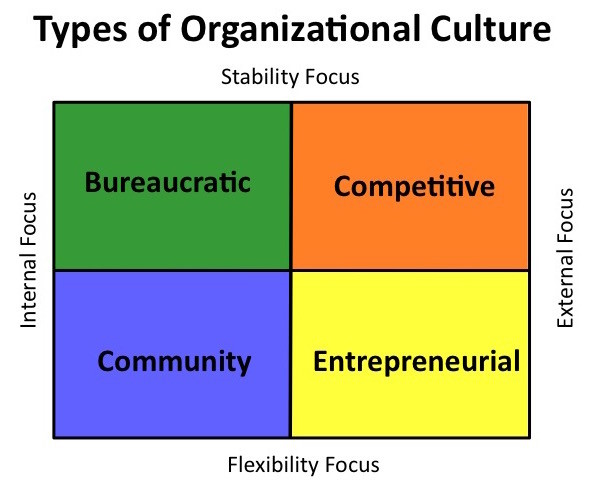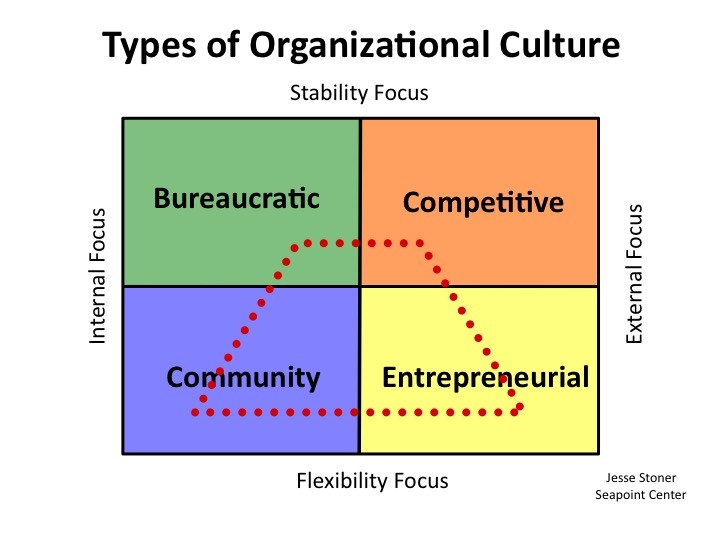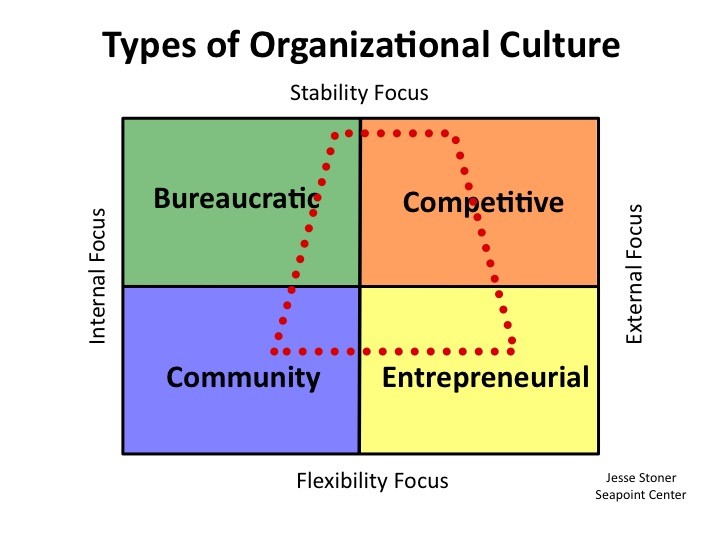 There are many types of organizational culture. Some cultures are fun-loving (Zappos) while others are more staid and rule-bound (Bank of America). Some cultures are caring (Patagonia), while others are cold and impersonal (Best Buy).
There are many types of organizational culture. Some cultures are fun-loving (Zappos) while others are more staid and rule-bound (Bank of America). Some cultures are caring (Patagonia), while others are cold and impersonal (Best Buy).
Organizational culture arises from the underlying assumptions, values and beliefs that determine how people behave. Culture can be described as the environment or atmosphere, but it’s more than that. You might think of it as an organization’s personality.
Culture drives the organization, and if it is not aligned with the business strategies, it will thwart your organization’s effectiveness. Peter Drucker, the founding father of modern business, is often quoted as having said, “Culture eats strategy for breakfast.”
Quinn & Rohrbaugh created the Competing Values Framework based on their research (1983), which showed two key variables that form four basic types of organizational culture.
1) To what extent the organization’s focus is internal (on employees) vs. external (on customers and the market
2) How much the organization leans toward stability and control or toward flexibility and change.
These two variables show 4 types of organizational culture, depicted on the diagram and described below.

Types of Organizational Culture
Bureaucratic
There is a well-defined, formal, structured work environment that depends on authority, hierarchy and procedures to keep the organization running smoothly. There is a focus on efficiency, reliability and smooth execution.
Goal: Predictability
Identity: Belonging – The organization will take care of you in exchange for loyalty.
Orientation: How things are done –accuracy, efficiency in task completion
Approach to work: Do things right
Leadership style: Authority
Downside: Red tape
Community
This is a friendly environment to work in. People are relationship-oriented and express themselves more openly. There is a high level of involvement and teamwork. A great value is placed on trust and morale, and at times established policies may be disregarded in order to maintain positive relationships.
Goal: Synergy
Identity: Belonging – You are part of a family that cares about you
Orientation: How things are done – teamwork
Approach to work: Do things together
Leadership style: Mentor
Downside: Group think
Competitive
There is a pervasive customer-focused, goal-oriented attitude with a strong emphasis on delivering results. Policies, procedures, and measures are aligned to respond to the demands of the market and meet customer needs. The environment is challenging and competitive. Top performers are rewarded and highly regarded.
Goal: Winning
Identity: Meritocracy
Orientation: Results – winning
Approach to work: Do things best
Leadership style: Coach
Downside: Stress and burnout
Entrepreneurial
There is an entrepreneurial, innovative environment where risk-taking, experimentation and creativity are more important than policies or procedures. Individual initiative and freedom are encouraged. The atmosphere is dynamic and free-wheeling, and roles are not always clearly defined.
Goal: Innovation
Identity: Individual initiative
Orientation: Results – creative new ways to solve problems
Approach to work: Do things differently
Leadership: Emergent (arises in relation to what’s needed)
Downside: Chaos
The Shape of Organizational Culture
Just as each individual’s personality is unique, so is each organization’s culture. Rarely does an organization’s culture lie entirely in one quadrant. For example, this shape would be typical of a tech startup. Free-wheeling, fun-loving, hard-working, creative, and innovative. Lots of mistakes, lots of learning. A strong sense of camaraderie. Think of Apple in its early days.

Over time, as that company matures, the shape of the organizational culture is likely to change. It might start to look more like the diagram below. Still outward focused, but less camaraderie, more focus on individual performance, and less tolerance for mistakes.

However, it might take a different shape, depending on several unpredictable factors such as the values and beliefs of new leaders, effects of disruptive technologies, and changes in regulations or the economy. The older and larger the organization is, the more set its culture becomes.
The Best Type of Organizational Culture
There is no one best culture. The best shape for your culture depends on your business and its goals. What’s important is that your culture and business strategies are aligned.
Monitoring your organization’s culture is as important as monitoring profits. If at some point you find your culture and business strategies are no longer aligned, you will need to think about culture change. When considering change, take a look at the opposite type of culture for clues on what’s needed, instead of dismissing the opposite (ex. collaborative is better than competitive). See my article Polarities Hold the Key to a Healthy Organizational Culture for more information.
Also keep in mind that most change efforts fail. For tips to ensure your change effort works, read: Why Most Change Efforts Fail and 7 Guidelines to Ensure Yours Succeeds and 3 Approaches to Culture Change: What Works.













Nice model especially with the changing configuration that occurs over the life of an organization.
Thanks Marye Gail. Your comments made me think it would be interesting to see if it’s possible to predict phases of an organization life cycle using this model as a map.
So important to identify, recognize and appreciate the value and impact of organizational culture. I liked referring to one of ours as “organic and dynamic” which aligns with your “community” description although there are some significant, different markers especially when it comes to leadership. If you think of an organization as a body, with a head and a brain no less, all the various systems are interdependent and the health is determined by a holistic approach. More on that another time.
Suffice to say here that the culture eating strategy thoughts and quotes have an interesting history. For example, The 1985 book “Organizational Culture and Leadership” by Edgar H. Schein included a precursor expression between quotation marks suggesting that it was already circulating: 2
More and more management consultants are recognizing these types of problems and are noting explicitly that, because “culture constrains strategy,” a company must analyze its culture and learn to manage within its boundaries or, if necessary, change it.
All good thoughts, Gary. There are many ways to look at organizational culture. I see it like slicing an apple – you can slice vertically, horizontally, or from any angle. I’d be interest to know what variables you use. Organic and dynamic sounds like it might be more like entrepreneurial than community. A recent interesting Harvard Business Review article, “The Culture Factor” used the dimension of “stability/flexibility” but their other dimension is “independent/interdependent.” Regarding the quote, I found no source material indicating Drucker actually said that, which is why I noted he is “often quoted as having said.” Much thanks for deepening the conversation!
It is very useful to see an organizational culture changing as the organization grows. It would also be important to add an ethical dimension. These last few months, we have been seeing organizations self destruct because of a lack of agreement on ethics from the top on down.
I agree we need to take a closer look at what happens in companies where there is a culture that tolerates or promotes unethical behavior, like the rampant sexism that is currently being revealed in the tech industry.
I love the visuals Jesse! Simple but powerful. Fun to consider how every culture evolves…
So glad to hear you found it useful, Chery. I’ve been thinking lately of development of culture as having some similarities to the development of personality.
Key thing to remember about culture…pickle barrel theory. Resist as it might when you put a cucumber into a pickle barrel it gets pickled. That’s why it’s best to use new folks well before they get pickled and can’t see the barrell they live in!
Great analogy. When the culture is responsible for the pickle you’re in, it doesn’t make sense to look at change from the individual level. You need to change the barrel.
I have to say that I believe the competing values framework is an insufficient attempt to organize culture for simple human comprehension. It, like so may others, is not memorable or actionable. Please visit my website and download Business Culture Decided. Use the contact form to let me know what you think.
Thanks for posting and generating thought.
I am reminded of the famous quote by George E.P. Box “All models are wrong but some are useful” Thanks for sharing an alternative model.
This article is so useful, however the four types of organisational culture could be interwoven so successful run of an organisation
Jesse,
loved this post as I have deeply appreciated others and gave you a shout out on my newsletter…wonder if you have any thoughts or recommendations about surveys to measure/monitor culture in small (30-75) organizations?
Hi Laura, Thanks for the shout out. I’ve been playing with a survey based on this model. If you’d like to test it out, send me an email.
Jesse,
Clear, helpful model for thinking about culture. Thanks. I particularly like the diagrams that show how strategy linked culture may require alteration over time. My experience is that companies, even those with positive cultures, have trouble standing back and analyzing them. And even more trouble projecting how they may need to reshape them as strategies change–which is happening more and more in this disruptive environment.
Your comment make me think about the importance of self-awareness – not only for individuals, but for companies as well, and emphasizes the need to monitor culture and not take it for granted. Many thanks for your insights Jeannie.
So nice reading about organisational culture. It added onto my knowledge.
Brilliant piece on just how organizational culture arises AND how it can morph for the times. I have a personal bias that a competitive culture (think Wall Street) might have serious ramifications for the communities at large. If decisions are based solely on “who wins”, my observation is that many people lose. Keeping talent might also be an issue–in my humble opinion.
Good points, Eileen. I think there are pros and cons to each type. The challenge is to manage to the upside and minimize the downside. The upside for a competitive culture is they are outward focused on market and customers and are often the best at customer-service. Unfortunately, as you point out, too many companies are hanging out in the downside.
Currently, many organizations are having a dynamic and creative culture with facilities like work from home too. Employees work best when they are relaxed and feel safer. Creating a perfect environment at workplace empowers employees and make them more loyal and committed to the organization. Culture is the only element which can efficiently replace machine bureaucracies of traditional organizations in a profound manner.
The definition of “culture” interests me. Typical is: “the way we do things around here” but because we aren’t victims, can often vote with our feet to leave a toxic organisation, and can often influence or enable change in our organisations, I prefer this:
“the way we choose to do things around here”
Sometimes the empowerment needs to be made explicit.
So culture becomes a collective choice. Interesting. But one thing to consider is that behavior can also be driven by policies and practices that are imposed and not chosen. For example, reward systems often set people up to be competitive with each other and don’t support collaboration, especially in sales environments.
Very interesting, i am wondering whether you have a list of all leadership styles? and maybe a tool to indicate it.
Hi Amir, I don’t think anyone would agree on what all the leadership styles are. For visionary leadership, I recommend the work of Jim Kouzes and Barry Posner – their book The Leadership Challenge and their assessment the LPI.